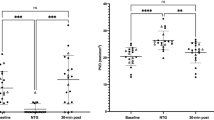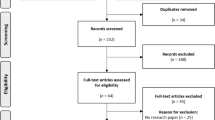Abstract
Introduction
Microcirculatory abnormalities are frequently observed in patients with severe heart failure and correlate to worse outcomes. We tested the hypothesis that nitroglycerin dose-dependently improves perfusion in severe heart failure and that this could be monitored by measuring central-peripheral temperature gradient and with Sidestream Dark Field imaging of the sublingual mucosa.
Methods
A dose-response study was performed in 17 patients with cardiogenic shock (n = 9) or end-stage chronic heart failure (n = 8) admitted to Erasmus University Medical Center. We did hemodynamic measurements at baseline and during increasing infusion rates of nitroglycerin (up to a maximum dose of 133 μg min−1). As parameters of tissue perfusion, we measured central-peripheral temperature gradient (delta-T) and sublingual perfused capillary density (PCD).
Results
Nitroglycerin dose-dependently decreased mean arterial pressure (p < 0.001) and cardiac filling pressures (both central venous pressure (CVP) and pulmonary capillary wedge pressure: p < 0.001). It increased cardiac index (p = 0.01). Nitroglycerin decreased delta-T (p < 0.001) and increased sublingual PCD (p < 0.001). Significant changes in delta-T and PCD occurred earlier, i.e., at a lower doses of NTG, than changes in global hemodynamics. Macrohemodynamic and microcirculatory responses to nitroglycerin infusion were consistent in patients with either cardiogenic shock or end-stage chronic heart failure. Changes in microcirculatory parameters occurred independently of changes in cardiac index.
Conclusions
Nitroglycerin dose-dependently increases tissue perfusion in patients with severe heart failure, as observed by a decrease in central-peripheral temperature gradient and an increase in sublingual perfused capillary density.


Similar content being viewed by others
References
Reynolds HR, Hochman JS (2008) Cardiogenic shock: current concepts and improving outcomes. Circulation 117:686–697
den Uil CA, Klijn E, Lagrand WK, Brugts JJ, Ince C, Spronk PE, Simoons ML (2008) The microcirculation in health and critical disease. Prog Cardiovasc Dis 51:161–170
Vincent JL, De Backer D (2005) Microvascular dysfunction as a cause of organ dysfunction in severe sepsis. Crit Care 9:S9–S12
Hasper D, Hummel M, Kleber FX, Reindl I, Volk HD (1998) Systemic inflammation in patients with heart failure. Eur Heart J 19:761–765
Reilly PM, Wilkins KB, Fuh KC, Haglund U, Bulkley GB (2001) The mesenteric hemodynamic response to circulatory shock: an overview. Shock 15:329–343
De Backer D, Creteur J, Dubois MJ, Sakr Y, Vincent JL (2004) Microvascular alterations in patients with acute severe heart failure and cardiogenic shock. Am Heart J 147:91–99
Lim N, Dubois MJ, De Backer D, Vincent JL (2003) Do all nonsurvivors of cardiogenic shock die with a low cardiac index? Chest 124:1885–1891
Joly HR, Weil MH (1969) Temperature of the great toe as an indication of the severity of shock. Circulation 39:131–138
Lima A, Jansen TC, van Bommel J, Ince C, Bakker J (2009) The prognostic value of the subjective assessment of peripheral perfusion in critically ill patients. Crit Care Med 37:934–938
Trzeciak S, McCoy JV, Phillip Dellinger R, Arnold RC, Rizzuto M, Abate NL, Shapiro NI, Parrillo JE, Hollenberg SM (2008) Early increases in microcirculatory perfusion during protocol-directed resuscitation are associated with reduced multi-organ failure at 24 h in patients with sepsis. Intensive Care Med 34:2210–2217
den Uil CA, Lagrand WK, Valk SD, Spronk PE, Simoons ML (2009) Management of cardiogenic shock: focus on tissue perfusion. Curr Probl Cardiol 34:330–349
Smith CJ, Sun D, Hoegler C, Roth BS, Zhang X, Zhao G, Xu X-B, Kobari Y, Pritchard K, Sessa WC, Hintze TH (1996) Reduced gene expression of vascular endothelial NO synthase and cyclooxygenase-1 in heart failure. Circ Res 78:58–64
Prabhu SD (2004) Nitric oxide protects against pathological ventricular remodeling: reconsideration of the role of NO in the failing heart. Circ Res 94:1155–1157
Schwarz M, Katz SD, Demopoulos L, Hirsch H, Yuen JL, Jondeau G, LeJemtel TH (1994) Enhancement of endothelium-dependent vasodilation by low-dose nitroglycerin in patients with congestive heart failure. Circulation 89:1609–1614
Mullens W, Abrahams Z, Francis GS, Sokos G, Taylor DO, Starling RC, Young JB, Tang WH (2009) Importance of venous congestion for worsening of renal function in advanced decompensated heart failure. J Am Coll Cardiol 53:589–596
Nohria A, Lewis E, Stevenson LW (2002) Medical management of advanced heart failure. JAMA 287:628–640
Elkayam U, Janmohamed M, Habib M, Hatamizadeh P (2008) Vasodilators in the management of acute heart failure. Crit Care Med 36:S95–S105
den Uil CA, Lagrand WK, Spronk PE, van der Ent M, Jewbali LS, Brugts JJ, Ince C, Simoons ML (2009) Low-dose nitroglycerin improves microcirculation in hospitalized patients with acute heart failure. Eur J Heart Fail 11:386–390
Salazar Vázquez BY, Wettstein R, Cabrales P, Tsai AG, Intaglietta M (2008) Microvascular experimental evidence on the relative significance of restoring oxygen carrying capacity vs. blood viscosity in shock resuscitation. Biochim Biophys Acta 10:1421–1427
Goedhart PT, Khalilzada M, Bezemer R, Merza J, Ince C (2007) Sidestream Dark Field (SDF) imaging: a novel stroboscopic LED ring-based imaging modality for clinical assessment of the microcirculation. Opt Express 15:15101–15114
De Backer D, Hollenberg S, Boerma C, Goedhart P, Büchele G, Ospina-Tascon G, Dobbe I, Ince C (2007) How to evaluate the microcirculation: report of a round table conference. Crit Care 11:R101
Dobbe JG, Streekstra GJ, Atasever B, van Zijderveld R, Ince C (2008) Measurement of functional microcirculatory geometry and velocity distributions using automated image analysis. Med Biol Eng Comput 46:659–670
Hubble SM, Kyte HL, Gooding K, Shore AC (2009) Variability in sublingual microvessel density and flow measurements in healthy volunteers. Microcirculation 16:183–191
Elkayam U, Bitar F, Akhter MW, Khan S, Patrus S, Derakhshani M (2004) Intravenous nitroglycerin in the treatment of decompensated heart failure: potential benefits and limitations. J Cardiovasc Pharmacol Ther 9:227–241
Elkayam U (1996) Nitrates in the treatment of congestive heart failure. Am J Cardiol 77:41C–51C
Vincent JL, Moraine JJ, van der Linden P (1988) Toe temperature versus transcutaneous oxygen tension monitoring during acute circulatory failure. Intensive Care Med 14:64–68
Lima A, Bakker J (2005) Noninvasive monitoring of peripheral perfusion. Intensive Care Med 31:1316–1326
De Backer D, Creteur J, Dubois MJ, Sakr Y, Koch M, Verdant C, Vincent JL (2006) The effects of dobutamine on microcirculatory alterations in patients with septic shock are independent of its systemic effects. Crit Care Med 34:403–408
Klijn E, Den Uil CA, Bakker J, Ince C (2008) The heterogeneity of the microcirculation in critical illness. Clin Chest Med 29:643–654
Kaluski E, Milo-Cotter O, Cotter G (2009) Death and life are in the power of the tongue? Cardiology 114:39–41
Spronk PE, Ince C, Gardien MJ, Mathura KR, Oudemans-van Straaten HM, Zandstra DF (2002) Nitroglycerin in septic shock after intravascular volume resuscitation. Lancet 360:1395–1396
Boerma EC, Kuiper MA, Kingma WP, Egbers PH, Gerritsen RT, Ince C (2008) Disparity between skin perfusion and sublingual microcirculatory alterations in severe sepsis and septic shock: a prospective observational study. Intensive Care Med 34:1294–1298
den Uil CA, Lagrand WK, Brugts JJ, Spronk PE (2008) Microcirculation and multi-organ failure in patients with sepsis. Intensive Care Med 34:2304
Author information
Authors and Affiliations
Corresponding author
Electronic supplementary material
Below is the link to the electronic supplementary material.
134_2009_1591_MOESM1_ESM.jpg
Electronic Supplementary Material. Aligned dot plots demonstrating the effects of nitroglycerin at the individual patient level. At each time point, changes relative to the averaged baseline measurements are shown. Lines represent mean. P values were obtained with one-way repeated measures ANOVA, followed by Bonferroni’s multiple comparison test of the specific time point compared to baseline (* p < 0.05; ** p < 0.01; *** p < 0.001). (JPG 561 kb)
Rights and permissions
About this article
Cite this article
den Uil, C.A., Caliskan, K., Lagrand, W.K. et al. Dose-dependent benefit of nitroglycerin on microcirculation of patients with severe heart failure. Intensive Care Med 35, 1893–1899 (2009). https://doi.org/10.1007/s00134-009-1591-4
Received:
Accepted:
Published:
Issue Date:
DOI: https://doi.org/10.1007/s00134-009-1591-4




